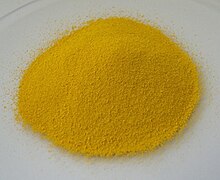Bismuth vanadate
| Structural formula | |||||||||||||
|---|---|---|---|---|---|---|---|---|---|---|---|---|---|

|
|||||||||||||
| General | |||||||||||||
| Surname | Bismuth vanadate | ||||||||||||
| other names |
|
||||||||||||
| Molecular formula | BiVO 4 | ||||||||||||
| External identifiers / databases | |||||||||||||
|
|||||||||||||
| properties | |||||||||||||
| Molar mass | 323.92 g mol −1 | ||||||||||||
| Physical state |
firmly |
||||||||||||
| density |
6.25 g cm −3 |
||||||||||||
| solubility |
almost insoluble in water |
||||||||||||
| safety instructions | |||||||||||||
|
|||||||||||||
| As far as possible and customary, SI units are used. Unless otherwise noted, the data given apply to standard conditions . | |||||||||||||
Bismuth vanadate , more rarely bismuth vanadium oxide , bismuth yellow or vanadium yellow is an inorganic, very greenish yellow pigment from the vanadate group . The chemical formula is BiVO 4 . The compound listed in the Color Index under CI Pigment Yellow 184 is one of the most important substitutes for the inorganic yellow pigments used in the past and now classified as toxic, lead chromate PbCrO 4 and cadmium sulfide CdS. Commercial products also often contain molybdenum or tungsten in place of vanadium in the crystal lattice. In addition to the classic green-tinged variant, red-tinged variants are now also available.
history
In contrast to the majority of inorganic pigments , bismuth vanadate only has a comparatively short history. The pigment group was only offered commercially in 1985. Although the synthesis was first documented in 1924, serious attempts at its use as a pigment did not begin until the 1970s. The worldwide annual requirement is now 1200 tons.
Occurrence
Bismuth vanadate occurs naturally in the minerals pucherite , clinobisvanite, and dreyerite . However, these are not important for the industrial production of the pigment.
Extraction and presentation
Production as a solid-state reaction
Bismuth (III) oxide and vanadium oxide react in a solid-state reaction to form bismuth vanadate.
Production from the precipitation process
Bismuth vanadate can also be synthesized by precipitation from a solution of bismuth nitrate and sodium metavanadate .
The color shade depends strongly on the temperature, pH value and concentration during the precipitation. In the case of industrially manufactured products, an aftertreatment is often applied to further increase alkali or weather resistance.
properties
Commercial types of bismuth vanadate have a density of approx. 6.5 g / cm 3 .
The suitability as a pigment is derived from the excellent hiding power , the unusually pure and light shade for inorganic pigments , the high color strength and the excellent weather resistance . At pH values above 12, however, the pigment is not stable to alkali. Only two of the four possible crystal modifications show the brilliant yellow tone. These four different main modifications also differ in their crystal structure. Bismuth vanadate, which occurs naturally as the mineral pucherite, has an orthorhombic structure with the space group Pnca (space group no. 60, position 3) and a 0 = 5.33 Å, b 0 = 5.05 Å and c 0 = 12.00 Å and thus differs significantly from the synthetic basic type, which crystallizes in a monoclinically distorted variant of the calcium tungstate lattice ( scheelite type) with the space group I 2 / a (no. 15, position 3) . To increase the stability of the synthetic bismuth vanadate lattice, however, the aim is to achieve a pure tetragonal modification of the space group I 4 1 / a (No. 88) . This tetragonal bismuth vanadate with a scheelite structure is obtained in the presence of the above-mentioned foreign ions, such as molybdenum and tungsten, alone or in combination with alkaline earth ions. According to Henning Wienand and Werner Ostertag, bismuth vanadate produced in the presence of sodium molybdate has a tetragonal structure with the lattice constants a 0 = 5.147 Å and c 0 = 11.722 Å. There is also another tetragonal bismuth vanadate modification that can be distinguished from the scheelite type, which has a crystal structure corresponding to zircon with the space group I 4 1 / amd (No. 141) , but which is not suitable as a pigment because of its significantly pale yellow .
Since bismuth vanadate is not toxic, it was introduced as a replacement for the toxic yellow pigments, which are outlawed in the (European) paint industry, lead chromate and cadmium sulfide .
use
In particular, the color shade, which is very similar to that of lead chromate and cadmium sulfide and at the same time significantly purer than that of nickel antimony titanate (CI Pigment Yellow 53), makes the pigment a frequently preferred choice for all types of paint applications.
When used in automotive coatings, industrial coatings, powder coatings and emulsion paints, bismuth vanadate is a standard selection for pigments. Due to its high weather resistance, the pigment is also suitable for outdoor use. The only exception to this is emulsion paints for use on the facade, as inadequate pretreatment of the substrate (e.g. covering with a primer ) can result in damage from alkalis that leak out of not fully hardened concrete .
Individual evidence
- ^ The Color of Art Pigment Database: Pigment Yellow artiscreation.com , David Myers. Retrieved July 15, 2016.
- ↑ a b c data sheet bismuth vanadate from AlfaAesar, accessed on February 5, 2010 ( PDF )(JavaScript required) .
- ^ Entry on bismuth vanadate in the GESTIS substance database of the IFA , accessed on July 23, 2016(JavaScript required) .
- ↑ a b c d e G. Buxbaum, G. Pfaff: Industrial Inorganic Pigments , Wiley-VCH
- ↑ Technical data sheet Sicopal Yellow L 1110
- ↑ J. Granzin et al. D. Pohl: Z. f. Kristallographie , 169, 289-294 (1984)
- ↑ WIF David u. AM Glazer: Phase Transitions , Vol. 1 (1979) 155-170
- ↑ The Bulletin of the Bismuth Institute, 53 (1988) 1-4
- ↑ Pigments of bismuth vanadate, their process of preparation and their use (Freepatentsonline)



